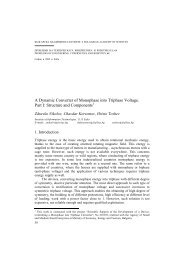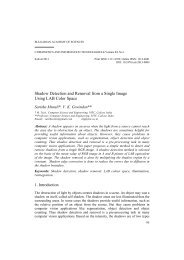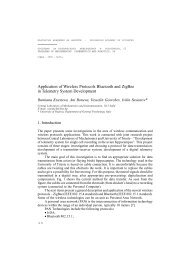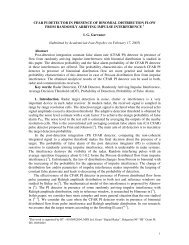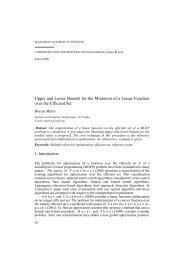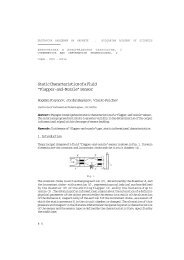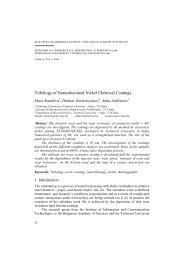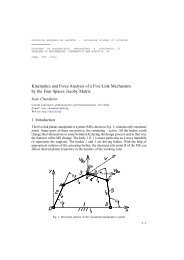CASE-based Development of Web-enabled Database Applications ...
CASE-based Development of Web-enabled Database Applications ...
CASE-based Development of Web-enabled Database Applications ...
Create successful ePaper yourself
Turn your PDF publications into a flip-book with our unique Google optimized e-Paper software.
БЪЛГАРСКА АКАДЕМИЯ НА НАУКИТЕ . BULGARIAN ACADEMY OF SCIENCES<br />
ПРОБЛЕМИ НА ТЕХНИЧЕСКАТА КИБЕРНЕТИКА И РОБОТИКАТА, 48<br />
PROBLEMS OF ENGINEERING CYBERNETICS AND ROBOTICS, 48<br />
София . 1999 . S<strong>of</strong>ia<br />
<strong>CASE</strong>-<strong>based</strong> <strong>Development</strong> <strong>of</strong> <strong>Web</strong>-<strong>enabled</strong> <strong>Database</strong><br />
<strong>Applications</strong>. The Promise and the Dead-end <strong>of</strong> the Relational<br />
Approach<br />
Vassil T. Vassilev<br />
Institute <strong>of</strong> Information Technologies, 1113 S<strong>of</strong>ia<br />
1. Introduction: the <strong>Web</strong>-<strong>enabled</strong> information systems as the key to the<br />
Information Society<br />
The first industrial technology, which solved successfully the complex task for automatic<br />
generation <strong>of</strong> <strong>Web</strong>-<strong>enabled</strong> information systems, is the one incorporated in ORACLE<br />
DESIGNER/2000 product suite <strong>of</strong> Oracle Corp [1]. Its <strong>Web</strong> generator produces<br />
PL/SQL-coded database applications for running under ORACLE WEB APPLICATION<br />
SERVER [2] as a background process (see Fig. 1). The <strong>Web</strong> Server Generator [5] was<br />
added to the DESIGNER/2000 toolkit in 1996 as complementary to the client-server<br />
generators from the ORACLE DEVELOPER/2000 suite Forms, Graphics and Reports. It<br />
is an additional alternative together with the programming generators producing<br />
applications coded in Visual Basic and C/C ++ , which were included earlier in the<br />
release. The <strong>Web</strong> Server Generator <strong>of</strong> DESIGNER/2000 is fully integrated with all visual<br />
diagrammers for developing applications with relational databases, which are the core<br />
<strong>of</strong> the relational concept <strong>of</strong> RAD. For the fist time they were producing fully featured<br />
and error free applications for remote Internet/intranet data management, entirely<br />
developed using graphical diagrammers, which employ the relational approach.<br />
In order to access the databases over the World Wide <strong>Web</strong> using standard <strong>Web</strong> browsers,<br />
such as NETSCAPE NAVIGATOR or MICROSOFT INTERNET EXPLORER, the respective URL should<br />
be visited first. It is in fact a virtual URL since its entering leads to an execution <strong>of</strong> application<br />
procedures, which are stored on the database server. The structure <strong>of</strong> such a virtual link is the<br />
following:<br />
http:\\:\\\<br />
3
Fig. 1. Internet/intranet access to database information through Oracle <strong>Web</strong> Application Server<br />
where the first part <strong>of</strong> the URL http:\\: specifies the Internet<br />
address <strong>of</strong> the <strong>Web</strong> server and the IP port on which the HTTP listener receives requests<br />
over WWW, while the second one is virtual only and it does not exist as a physical<br />
address. It provides specific to the WEB APPLICATION SERVER information instead. When<br />
processed it is dynamically converted into execution <strong>of</strong> respective stored database<br />
procedures; for example, the URL<br />
http:\\owas.iinf.acad.bg:8888\owa_dba\plsql\main$.startup<br />
points to the <strong>Web</strong> server <strong>of</strong> the Institute <strong>of</strong> Information Technologies, which is a<br />
Windows NT computer named owas.iinf.acad.bg with non-secure IP port 8888 listening<br />
to HTTP requests. Behind the curtains this virtual URL hides the fact, that the host<br />
owas.iinf.acad.bg runs the ORACLE WEB APPLICATION SERVER FOR NT and it also acts as<br />
a home for the ORACLE 7 WORKGROUP SERVER FOR NT. The HTML page supplied in<br />
response to the external requests via this URL over the World Wide <strong>Web</strong> is dynamically<br />
generated during execution <strong>of</strong> the procedure startup. It belongs to the user scheme<br />
where the PL/SQL package main is stored on the server.<br />
Although the procedures, which WEB APPLICATION SERVER executes for generating<br />
HTML, could be written in any CGI-compliant languages PL/SQL, Java, Perl, VRML<br />
etc., for the purpose <strong>of</strong> the <strong>CASE</strong>-<strong>based</strong> design only PL/SQL might be used. The<br />
reason for stacking to this somewhat old fashion language in the presence <strong>of</strong> much<br />
more modern, object-oriented languages like C ++ and Java, is the clear advantage <strong>of</strong><br />
using native database language. The new version <strong>of</strong> DESIGNER/2000 [7,4] will also<br />
allow Java to be directly generated by the <strong>Web</strong> Generator, but this will be a real<br />
advantage only when Java becomes a native language for the database server.<br />
2. The Oracle <strong>CASE</strong> Story: 100%Authomatic Generation<br />
DESIGNER/2000 as a <strong>CASE</strong> tool for RAD <strong>of</strong> information system is built on top <strong>of</strong> the<br />
success <strong>of</strong> RDBMS developed by Oracle and others last two decades. It is a graphical<br />
front-end to set <strong>of</strong> typical components <strong>of</strong> the design process, layered into three separate<br />
logical levels: modellers, designers and generators. The main two modellers from the<br />
toolkit cover both the data processing and the data management components <strong>of</strong> the<br />
design process:<br />
4
Business Process Modeller, used for specification <strong>of</strong> business processes on logical<br />
level using high-level terms, such as business function, datastore, dataflow, decision<br />
point, triggering event and output report<br />
Entity Relationship Modeller, giving the abstract model <strong>of</strong> data in terms <strong>of</strong><br />
entities, attributes, and relations<br />
The design layer includes several visual diagrammers, which specify the physical<br />
implementation <strong>of</strong> the information system – database and program modules - using<br />
schema diagrams and layout preferences:<br />
Data Diagrammer is used for physical design <strong>of</strong> the database (tables, views,<br />
snapshots, etc.)<br />
Module Data Diagrammer designs the interactive applications built on top <strong>of</strong><br />
the existing data stored in the database (for querying, inserting, updating and deleting)<br />
Module Logic Diagrammer helping the process <strong>of</strong> writing programming logic<br />
(procedures, functions and triggers in PL/SQL for storing on the server) and<br />
Module Structure Diagrammer necessary for specification <strong>of</strong> the structural links<br />
between complex sets <strong>of</strong> modules, comprising the interactive applications <strong>of</strong> the<br />
information system<br />
All the components included in the two levels are unified and tidely integrated.<br />
They work as visual diagrammers, which allow specifying the internal components,<br />
the external links and the display preferences <strong>of</strong> the diagrams in focus in a highly<br />
simplified and helpful manner. Based on the descriptions behind the visual diagrams,<br />
on the next level the respective programming generators can produce interactive<br />
applications, which implement particular information systems for processing data from<br />
the database.<br />
Fig. 2. <strong>CASE</strong>-<strong>based</strong> approach for development <strong>of</strong> <strong>Web</strong>-<strong>enabled</strong> database applications<br />
<strong>Web</strong>-<strong>enabled</strong> applications could be also developed using the same <strong>CASE</strong>-<strong>based</strong><br />
technology through the <strong>Web</strong>Server Generator (see Fig. 2). Briefly this process works<br />
5
in the following way. First, using the data and module diagrams prepared during the<br />
design stage, the <strong>Web</strong>Server Generator generates several PL/SQL packages for storing<br />
and manipulating data. They are then installed on the <strong>Database</strong> Server using PL/SQL<br />
interpreter. During realtime already, when the listener <strong>of</strong> the WEB APPLICATION SERVER<br />
accepts requests for visiting particular URL’s from certain <strong>Web</strong> browser, it passes<br />
them to the <strong>Web</strong> Request Broker component <strong>of</strong> the WEB APPLICATION SERVER, which<br />
directs them to the respective cartridge for interpretation. In this case this is the PL/<br />
SQL cartridge. It interprets the code <strong>of</strong> the corresponding PL/SQL procedures stored<br />
on the database server and returns the result in the form <strong>of</strong> HTML code, which is<br />
itself returned by the HTTP server to be interpreted by the <strong>Web</strong> browser <strong>of</strong> the remote<br />
client. When this interaction includes several steps for full data processing, e.g. queryview-update<br />
sequence <strong>of</strong> actions, this procedure is repeated under the control <strong>of</strong> the<br />
client logic using standard HTML mechanisms clicking URL’s, filling forms,<br />
submitting buttons, etc.<br />
3. An example: development for the <strong>Web</strong> using Designer/2000<br />
Let take an example <strong>of</strong> simple <strong>of</strong>fice information system. It deals with information<br />
about the <strong>of</strong>fice departments and the staff working in them. The information will be<br />
accessed over the corporate intranet, or from the World Wide <strong>Web</strong>. On the Fig.3 is<br />
shown the screen <strong>of</strong> the Data Diagrammer with the physical data diagram <strong>of</strong> this<br />
system, converted from the corresponding Entity-Relationship model. The only two<br />
tables in this application represent the departments (DEPT) and employees (EMP)<br />
together with some relationships <strong>of</strong>ficially recorded by the company. They are placed<br />
in the VASSIL datascheme, and EMP_ID and DEPT_ID columns identify the records,<br />
respectively. The columns in the table DEPT which describe the information about<br />
departments are DEPT_DEPTNO, standing for its registration number,<br />
DEPT_NAME, for its name and DEPT_LOC for address information. The columns<br />
EMP_EMPNO in the EMP table stand for the number, EMP_EMPNAME for the<br />
name, EMP_JOB for the job and EMP_MGR for the duties <strong>of</strong> the employees. The<br />
two tables are related via Works-in relation (EMP_DEPT_FK is the foreign key in<br />
6<br />
Fig. 3 Table design for simple <strong>of</strong>fice application
the EMP table pointing to the corresponding record in the DEPT table, while<br />
EMP_DEPT_ID is the placeholder for it in EMP). In addition, the reflective relation<br />
Supervised-by gives information about the personal chiefs <strong>of</strong> each staff member (it is<br />
denoted as EMP_EMP_FK with EMP_EMP_ID as a placeholder for it).<br />
After completion <strong>of</strong> the database design the corresponding DDL commands could<br />
be generated by the Server Generator <strong>of</strong> the toolkit (see the listing on Fig. 4). They<br />
contain SQL statements for creation <strong>of</strong> tables, for indexing <strong>of</strong> records, for checking<br />
primary, unique and foreign key constraints, etc 1 .<br />
Immediately afterwards or, alternatively, somewhat later they should be executed<br />
on the server which will act as a database server through standard SQL interpreter,<br />
such as SQL*Plus. Directly from the data diagram the <strong>Web</strong> Server Generator generates<br />
the PL/SQL package for accessing the database tables from WWW via the WEB<br />
APPLICATION SERVER; this package is called Application Programming Interface for<br />
that table (API). One pair <strong>of</strong> files will be automatically generated per each table in the<br />
database (Fig. 5): .pks file for the forward declarations, and the .pkb file for the<br />
procedure code. The structure <strong>of</strong> the API package CG$DEPT generated for the table<br />
DEPT <strong>of</strong> our system is listed on Fig. 6, while the code is shown on Fig. 7.<br />
REM<br />
REM This ORACLE7 command file was generated by Oracle Server Generator<br />
REM Version 5.5.10.0.0 on 19-MAR-98<br />
REM<br />
REM For application VASSIL version 1 database VASSIL<br />
PROMPT Creating tables…<br />
CREATE TABLE dept(dept_id NUMBER(10,0) NOT NULL,<br />
dept_deptno INTEGER NOT NULL,<br />
dept_dname VARCHAR2(240) NOT NULL,<br />
dept_loc VARCHAR2(240) NULL);<br />
CREATE TABLE emp(emp_id NUMBER(10,0) NOT NULL,<br />
emp_dept_id NUMBER(10,0) NOT NULL,<br />
emp_empno INTEGER NOT NULL,<br />
emp_ename VARCHAR2(240) NOT NULL,<br />
emp_job VARCHAR2(240) NOT NULL,<br />
emp_emp_id NUMBER(10,0) NULL,<br />
emp_mgr VARCHAR2(240) NULL);<br />
PROMPT Creating sequences…<br />
CREATE SEQUENCE dept_seq INCREMENT BY 1<br />
START WITH 1 MINVALUE 1 NOMAXVALUE<br />
NOCYCLE NOCACHE NOORDER;<br />
CREATE SEQUENCE emp_seq INCREMENT BY 1<br />
START WITH 1 MINVALUE 1 NOMAXVALUE<br />
NOCYCLE NOCACHE NOORDER;<br />
PROMPT Adding Primary Key constraints to the tables…<br />
ALTER TABLE DEPT ADD (CONSTRAINT DEPT_PK PRIMARY KEY (DEPT_ID)<br />
USING INDEX PCTFREE 10);<br />
ALTER TABLE EMP ADD (CONSTRAINT EMP_PK PRIMARY KEY (EMP_ID)<br />
USING INDEX PCTFREE 10);<br />
PROMPT Adding Unique Key constraints to the tables…<br />
ALTER TABLE DEPT ADD (CONSTRAINT DEPT_DEPT0_UK UNIQUE (DEPT_DEPTNO)<br />
USING INDEX PCTFREE 10);<br />
ALTER TABLE DEPT ADD (CONSTRAINT DEPT_DEPT1_UK UNIQUE (DEPT_DEPTNO)<br />
USING INDEX PCTFREE 10);<br />
ALTER TABLE EMP ADD (CONSTRAINT EMP_EMP0_UK UNIQUE (EMP_EMPNO)<br />
USING INDEX PCTFREE 10);<br />
ALTER TABLE EMP ADD (CONSTRAINT EMP_EMP1_UK UNIQUE (EMP_EMPNO)<br />
USING INDEX PCTFREE 10);<br />
PROMPT Adding Foreign Key constraints to the tables…<br />
ALTER TABLE EMP ADD (CONSTRAINT EMP_DEPT_FK FOREIGN KEY (EMP_DEPT_ID)<br />
REFERENCES DEPT (DEPT_ID));<br />
ALTER TABLE EMP ADD (CONSTRAINT EMP_EMP_FK FOREIGN KEY (EMP_EMP_ID)<br />
REFERENCES EMP (EMP_ID));<br />
PROMPT Creating Table Indexes…<br />
CREATE INDEX EMP_DEPT_FK_I ON EMP (emp_dept_id) PCTFREE 10;<br />
CREATE INDEX EMP_EMP_FK_I ON EMP (emp_emp_id) PCTFREE 10;<br />
Fig. 4. DDL statements in SQL for generation <strong>of</strong> the <strong>of</strong>fice information system database<br />
1<br />
Actually the DDL statemnts necessary for creating the database are spread among different files with the<br />
same name and different extensions one for the the tables.tab, one for the sequences .seg,one for the<br />
constraints .con and one for the indexes .ind.<br />
7
Fig. 5. Generating PL/SQL packages for <strong>Web</strong> Server <strong>Database</strong> API<br />
————————————————————————————————————————<br />
— Name: cg$DEPT<br />
— Description: DEPT table API package declarations<br />
————————————————————————————————————————<br />
CREATE OR REPLACE PACKAGE cg$DEPT IS<br />
— Primary key <strong>of</strong> the DEPT table<br />
DEPT_PK CONSTANT VARCHAR2(240) := ‘’;<br />
— Column default prompts<br />
P2_DEPT_DEPTNO CONSTANT VARCHAR2(240) := ‘Dept No.’;<br />
P3_DEPT_DNAME CONSTANT VARCHAR2(240) := ‘Dept Name’;<br />
P4_DEPT_LOC CONSTANT VARCHAR2(240) := ‘Dept Location’;<br />
— DEPT row type<br />
cg$row DEPT%ROWTYPE;<br />
— DEPT row type variables<br />
TYPE cg$row_type IS RECORD<br />
(DEPT_DEPTNO cg$row.DEPT_DEPTNO%TYPE<br />
,DEPT_DNAME cg$row.DEPT_DNAME%TYPE<br />
,DEPT_LOC cg$row.DEPT_LOC%TYPE<br />
,DEPT_ID cg$row.DEPT_ID%TYPE<br />
,JN_NOTES VARCHAR2(240));<br />
TYPE cg$ind_type IS RECORD<br />
(DEPT_DEPTNO BOOLEAN DEFAULT FALSE<br />
,DEPT_DNAME BOOLEAN DEFAULT FALSE<br />
,DEPT_LOC BOOLEAN DEFAULT FALSE<br />
,DEPT_ID BOOLEAN DEFAULT FALSE);<br />
8
TYPE cg$pk_type IS RECORD<br />
(DEPT_ID cg$row.DEPT_ID%TYPE, JN_NOTES VARCHAR2(240));<br />
— Procedures for accessing DEPT from <strong>Web</strong> Application Server side<br />
PROCEDURE ins(cg$rec IN OUT cg$row_type<br />
,cg$ind IN OUT cg$ind_type);<br />
PROCEDURE upd(cg$rec IN OUT cg$row_type<br />
,cg$ind IN OUT cg$ind_type);<br />
PROCEDURE del(cg$pk IN cg$pk_type);<br />
PROCEDURE lck(cg$old_rec IN cg$row_type<br />
,cg$old_ind IN cg$ind_type<br />
,nowait_flag IN BOOLEAN DEFAULT TRUE);<br />
END cg$DEPT;<br />
Fig. 6 Structure <strong>of</strong> the PL/SQL package for the database API<br />
————————————————————————————————————————<br />
— Name: cg$DEPT<br />
— Description: DEPT table API package definitions<br />
————————————————————————————————————————<br />
CREATE OR REPLACE PACKAGE BODY cg$DEPT IS<br />
PROCEDURE err_msg(msg IN VARCHAR2, type IN INTEGER, loc IN VARCHAR2 DEFAULT<br />
‘’);<br />
————————————————————————————————————————<br />
— Name: err_msg<br />
— Description: Pushes onto stack appropriate user defined error message<br />
— depending on the rule violated<br />
— Parameters: msg Oracle error message<br />
— type Type <strong>of</strong> violation e.g. check_constraint: ERR_CHECK_CON<br />
— loc Place where this procedure was called for error trapping<br />
<br />
…<br />
PROCEDURE err_msg(msg IN VARCHAR2, type IN INTEGER, loc IN VARCHAR2 DEFAULT<br />
‘’) IS<br />
con_name VARCHAR2(240);<br />
BEGIN<br />
con_name := cg$errors.parse_constraint(msg, type);<br />
IF (1=2) THEN<br />
NULL;<br />
ELSIF (con_name = ‘DEPT_PK’ AND DEPT_PK IS NOT NULL) THEN<br />
cg$errors.push(DEPT_PK, ‘E’, ‘API’, -9999, loc);<br />
ELSIF (con_name = ‘EMP_DEPT_FK’ AND type = cg$errors.ERR_DELETE_RESTRICT)<br />
THEN<br />
cg$errors.push(cg$errors.MsgGetText(4, cg$errors.ERR_DEL_RESTRICT,<br />
‘Dept’, ‘Emp’),<br />
‘E’, ‘API’, -9999, loc);<br />
ELSE<br />
cg$errors.push(SQLERRM, ‘E’, ‘ORA’, SQLCODE, loc);<br />
END IF;<br />
END err_msg;<br />
<br />
…<br />
————————————————————————————————————————<br />
— Name: ins<br />
— Description: API insert procedure<br />
9
— Parameters: cg$rec Record <strong>of</strong> row to be inserted<br />
— cg$ind Record <strong>of</strong> columns specifically set<br />
————————————————————————————————————————<br />
PROCEDURE ins(cg$rec IN OUT cg$row_type,<br />
cg$ind IN OUT cg$ind_type) IS<br />
cg$tmp_rec cg$row_type;<br />
BEGIN<br />
up_autogen_columns(cg$rec, cg$ind, ‘INS’); — Autogen + Upper<br />
INSERT INTO DEPT (DEPT_DEPTNO, DEPT_DNAME, DEPT_LOC, DEPT_ID)<br />
VALUES (cg$rec.DEPT_DEPTNO, cg$rec.DEPT_DNAME, cg$rec.DEPT_LOC,<br />
cg$rec.DEPT_ID);<br />
slct(cg$rec);<br />
EXCEPTION<br />
WHEN cg$errors.mandatory_missing THEN<br />
validate_mandatory(cg$rec, ‘cg$DEPT.ins.mandatory_missing’);<br />
cg$errors.raise_failure;<br />
<br />
…<br />
WHEN OTHERS THEN<br />
cg$errors.push(SQLERRM, ‘E’, ‘ORA’, SQLCODE, ‘cg$DEPT.ins.others’);<br />
cg$errors.raise_failure;<br />
END ins;<br />
<br />
…<br />
END cg$DEPT;<br />
Fig. 7. Body <strong>of</strong> the generated PL/SQL package for the table DEPT<br />
Later on, or in parallel with the database specification, design and generation<br />
process described here, one could also develop the application for database<br />
management according to the business logic <strong>of</strong> information processing. On Fig. 8 is<br />
shown the screen <strong>of</strong> the Module Data Diagrammer containing the module design for<br />
sample <strong>of</strong>fice information system, which could be used for registration <strong>of</strong> the staff<br />
from the different departments.<br />
The module has two components, which are placed on the diagram in a sequence<br />
from top to bottom. The first component contains one table usage, namely the basic<br />
usage <strong>of</strong> the database table DEPT, required for stating department before inserting<br />
any staff information. The second module contains two usages <strong>of</strong> the table EMP one<br />
master-detail usage, corresponding to the relation Works-in and one lookup usage <strong>of</strong><br />
the same table, corresponding to the reflective relation Supervised-by. From this diagram<br />
after clicking the proper button the <strong>Web</strong> Server Generator <strong>of</strong> DESIGNER/2000 produces<br />
three separate PL/SQL packages one per each module component plus one master<br />
package for the whole application (see Fig. 9).<br />
1 0
Fig. 8. Module design <strong>of</strong> database table usages containing both master-detail and look-up relationships<br />
Fig. 9. Generating PL/SQL packages for <strong>Web</strong> Server <strong>Database</strong> Application<br />
1 1
The structure <strong>of</strong> the packages is specified by the PL/SQL code generated in the<br />
.pks file for this module, produced by the <strong>Web</strong> Server Generator. It contains forward<br />
declarations <strong>of</strong> the procedures for that package (see Fig. 10). Each package has one<br />
main procedure named Startup and several other procedures corresponding to the<br />
DML statements in SQL, but customised according to the module logic. For the set <strong>of</strong><br />
three packages generated for our <strong>of</strong>fice information system from module diagram<br />
OFFICE they are:<br />
1 2<br />
create or replace package OFFICE$ is<br />
procedure Startup;<br />
procedure FirstPage;<br />
procedure ShowAbout;<br />
end;<br />
create or replace package OFFICE$DEPT is<br />
procedure Startup;<br />
procedure ActionQuery(<br />
P_DEPT_DNAME in varchar2 default null,<br />
Z_ACTION in varchar2 default null);<br />
procedure QueryView(<br />
P_DEPT_ID in varchar2 default null,<br />
Z_JUST_NON_BASE in boolean default false,<br />
Z_FORM_STATUS in number default WSGL.FORM_STATUS_OK);<br />
procedure QueryList(<br />
P_DEPT_DNAME in varchar2 default null,<br />
Z_START in varchar2 default null,<br />
Z_ACTION in varchar2 default null);<br />
procedure QueryFirst(<br />
P_DEPT_DNAME in varchar2 default null,<br />
Z_ACTION in varchar2 default null);<br />
function QueryHits(<br />
P_DEPT_DNAME in varchar2 default null) return number;<br />
end;<br />
create or replace package OFFICE$EMP is<br />
procedure Startup(<br />
P_EMP_DEPT_ID in varchar2);<br />
procedure FormInsert(<br />
P_EMP_DEPT_ID in varchar2 default null,<br />
Z_FORM_STATUS in number default WSGL.FORM_STATUS_OK);<br />
procedure QueryView(<br />
P_EMP_ID in varchar2 default null,<br />
Z_JUST_NON_BASE in boolean default false,<br />
Z_FORM_STATUS in number default WSGL.FORM_STATUS_OK);<br />
procedure QueryList(<br />
P_EMP_DEPT_ID in varchar2 default null,<br />
Z_START in varchar2 default null,<br />
Z_ACTION in varchar2 default null);<br />
procedure QueryFirst(<br />
P_EMP_DEPT_ID in varchar2 default null,<br />
Z_ACTION in varchar2 default null);<br />
function QueryHits(<br />
P_EMP_DEPT_ID in varchar2 default null) return number;<br />
procedure ActionInsert(<br />
P_EMP_EMPNO in varchar2 default null,<br />
P_EMP_ENAME in varchar2 default null,<br />
P_EMP_JOB in varchar2 default null,<br />
P_EMP_MGR in varchar2 default null,<br />
P_EMP_DEPT_ID in varchar2 default null,<br />
Z_ACTION in varchar2 default null);<br />
end;<br />
Fig. 10 Structure <strong>of</strong> the generated PL/SQL packages for the <strong>of</strong>fice application module<br />
OFFICE$: Startup is the main procedure <strong>of</strong> the module. It begins the interactive<br />
session invoking the procedure FirstPage. The only work the procedure FirstPage<br />
does is to invoke proper procedures from the package corresponding to the second<br />
component, in this case OFFICE$DEPT.
OFFICE$DEPT: the procedure ActionQuery queries the database table DEPT<br />
using specified by the user criteria, QueryList shows the list <strong>of</strong> records which match<br />
the stated criteria, QueryFirst shows the first <strong>of</strong> them while QueryView is used for<br />
detailed description <strong>of</strong> any record in that table;<br />
OFFICE$EMP: this package besides the procedures which are also present in<br />
OFFICE$DEPT package contains the procedures FormInsert and ActionInsert which<br />
organize the inserting <strong>of</strong> new records in the table EMP with information for the staff<br />
members.<br />
Fig. 11. Working with the Office Information System over WWW using INTERNET EXPLORER<br />
The package bodies <strong>of</strong> the packages (.pkb files) may contain also some auxiliary<br />
procedures, which are not public, but using the procedures declared in the files with<br />
forward declarations (.pks files) all the build-in functionality <strong>of</strong> the package is available.<br />
In this way, the generated packages could be used for implementing different business<br />
functions. However, only one <strong>of</strong> them is an entry point for data processing according<br />
to the designed module logic. The actual screen <strong>of</strong> a <strong>Web</strong> browser during running <strong>of</strong><br />
the real <strong>of</strong>fice information system according to the above module logic at the stage <strong>of</strong><br />
information processing specified in the second module component is shown on<br />
Fig. 11.<br />
4. 100% or less<br />
All dynamically generated from WEB APPLICATION SERVER HTML pages, which are<br />
designed using <strong>Web</strong>Server Generator <strong>of</strong> DESIGNER/2000, belong to the following<br />
categories <strong>of</strong> interactive forms (Fig. 12):<br />
Startup Page; organises the sequence <strong>of</strong> virtual pages in one logical sequence<br />
<strong>of</strong> HTML frames or pages without data processing functions.<br />
1 3
About Page; contains only information logs with no data processing functions.<br />
Query Form; generates an interactive form for entering <strong>of</strong> combination <strong>of</strong><br />
search criteria concerning one particular basic table usage.<br />
Query First/List Form; shows the list <strong>of</strong> records matching the entered search<br />
criteria in a table form.<br />
Action View/Insert/Update Form; shows one particular record from the list <strong>of</strong><br />
records shown on the Record List form;<br />
Delete Confirmation Page; introduce an additional level <strong>of</strong> security for<br />
confirmation <strong>of</strong> deleting operations.<br />
These interactive forms have been used for long time in many approaches for<br />
developing information systems before coming <strong>of</strong> the <strong>Web</strong>, e.g. in terminal-<strong>based</strong><br />
centralised systems, in client/server distributed systems, in visual applications<br />
programmed using languages like VISUAL BASIC, VISUAL C, etc. When using the <strong>CASE</strong> tool<br />
for RAD <strong>of</strong> information systems, however, these forms could be automatically generated by<br />
the <strong>Web</strong> Generator from specifications <strong>of</strong> the table and column usages, layout preferences and<br />
display styles. They could be given completely interactively using the diagrammers and<br />
navigators included in the DESIGNER/2000 toolkit.<br />
Fig. 12. Dynamically generated HTML forms for <strong>Web</strong>-access to database tables<br />
It sounds good, because these forms cover most <strong>of</strong> the known data usages in<br />
contemporary data processing, but in practice it is far from sufficient for building real<br />
<strong>Web</strong> applications although for quite different reason. Roughly speaking, the essential<br />
drawback <strong>of</strong> this approach is rooted in the way the <strong>Web</strong> Generator produces the<br />
PL/SQL packages for the designed applications from the respective module<br />
specifications (see the forward definitions <strong>of</strong> the generated procedures on Fig. 10).<br />
Each PL/SQL packages may contain procedures for generating <strong>of</strong> all the above listed<br />
data usages, but per package they could use not more than one basic table or view.<br />
This simply means, that if Your application uses data from N tables, N packages will<br />
be generated, too, and each <strong>of</strong> them will contain respective sequence <strong>of</strong> “query form-<br />
1 4
ecord list-view form” data usages <strong>of</strong> that table. This pattern for organising <strong>of</strong> the<br />
modules is employed here because it is especially convenient in <strong>Web</strong> setting, since<br />
this way one dynamically generated HTML form could refer to at most one basic<br />
table. From the point <strong>of</strong> view <strong>of</strong> the design process this could be regarded as very low<br />
level <strong>of</strong> data granularity. It could be much more useful, if the level <strong>of</strong> granularity<br />
changes from entire table usage to separate column usage instead. Unfortunately, it is<br />
not possible without compete revising <strong>of</strong> the generation strategy. The fact, that even 2<br />
years after issuing <strong>of</strong> the first family <strong>of</strong> the suite the next family does not address fully<br />
this issue either, only confirms that the <strong>CASE</strong> strategy here should be completely<br />
revised.<br />
The second fundamental shortcoming <strong>of</strong> the approach employed by DESIGNER/<br />
2000 concerns the module application logic. If we would like to program more realistic<br />
applications in accordance to the full logic, at the design level we should be able to<br />
describe the characteristics <strong>of</strong> the data manipulation module and to transfer them<br />
beyond the current computation point. But since HTTP is a stateless protocol, after<br />
completion <strong>of</strong> the data manipulation at particular virtual URL all the parameters<br />
associated with the underlying PL/SQL procedure expire. Because <strong>of</strong> this restriction<br />
the only way to extend the state beyond the current URL is to make an explicit parameter<br />
passing from the calling PL/SQL procedure to the called one. Unfortunately, the <strong>Web</strong><br />
Generator again does not make distinction between the abstract module parameters<br />
and the programming language variables. As a consequence, the precise mapping<br />
during package generation cannot be done automatically and the module parameters<br />
stay completely useless. For this to be changed, we should be able to distinguish better<br />
the mechanisms <strong>of</strong> parameter passing between the procedures (implementation level<br />
<strong>of</strong> granularity), from the package export/import between modules (design level <strong>of</strong><br />
granularity).<br />
Even worse: the <strong>Web</strong> Generator does not allow during module structure design<br />
to use even very basic programming constructs besides simple sequencing and<br />
branching. The internal logic <strong>of</strong> the module also follows directly the “hardwired”<br />
patterns <strong>of</strong> query/view interactions during all data manipulation sessions. Even the<br />
very basic “if-then-else” conditional, which is necessary for implementing <strong>of</strong> the simplest<br />
logic at design level is impossible within the Designer. Here the 100% generation<br />
concept fails to respect even the basic requirements behind the design process. This<br />
means, that after finishing <strong>of</strong> the application generation we should additionally tune<br />
the intermodule logic at finer level <strong>of</strong> granularity, which in practice requires reprogramming<br />
<strong>of</strong> all dynamic HTML generation afterwards, using the WEB APPLICATION<br />
SERVER PL/SQL Toolkit. For example, the only way to program cyclic sequence <strong>of</strong><br />
dynamically generated HTML forms is to use the underlying recursive calls <strong>of</strong> the<br />
PL/SQL procedures implementing them, controlling the recursion using standard<br />
buttons. Even the new, second release <strong>of</strong> DESIGNER/2000 which is expected this year<br />
allows do not solve this issues. Although it is claimed to be possible at design time to<br />
incorporate some logic into the modules using the underlying control structures <strong>of</strong><br />
PL/SQL [3], it does not address the intermodule logic in any way.<br />
5. The next round: Object-oriented <strong>CASE</strong><br />
ORACLE DESIGNER/2000 is not a new product. Its predecessor, ORACLE <strong>CASE</strong> DESIGNER,<br />
failed to cover the entire process <strong>of</strong> development <strong>of</strong> information systems in all its<br />
aspects from business modelling, through system analysis, to s<strong>of</strong>tware development,<br />
generation and documentation. Although the currently available version <strong>of</strong> the<br />
DESIGNER/2000 is somewhat out <strong>of</strong> date, it is still a valuable tool because <strong>of</strong> its extreme<br />
1 5
power and useful set <strong>of</strong> utilities. There are some other s<strong>of</strong>tware tools and <strong>CASE</strong><br />
environments, which could be used in the process <strong>of</strong> development <strong>of</strong> information<br />
systems as well, but they are either too restrictive, like S-DESIGNOR from Powers<strong>of</strong>t, or<br />
are oriented towards general s<strong>of</strong>tware development, like OMTOOL, JBUILDER, etc., to<br />
mention some. However, they cannot be directly used for RAD. DESIGNER/2000 is still<br />
the only available tool on the market for rapid enterprise information system<br />
development which takes the full advantages <strong>of</strong> the re’s – redesign, regeneration,<br />
reusability and reengineering. Unfortunately, its <strong>Web</strong> generator does not respect very<br />
well the specifics <strong>of</strong> the underlying HTTP protocol, which still dominates the WWW<br />
as a medium for remote access to databases. Even the last version, announced some<br />
time ago [3, 4] does not change the underlying problems. There are two complementary<br />
trends, which will soon change the picture.<br />
First, the concept <strong>of</strong> navigation or the “drill-down” metaphor plays an important<br />
role here. It has recently re-appeared in s<strong>of</strong>tware engineering as a keyword in <strong>CASE</strong><br />
setting [4]. It could rather soon replace the concept <strong>of</strong> relating entities, the core <strong>of</strong> the<br />
relational point <strong>of</strong> view, with the concept <strong>of</strong> focusing on an object under investigation,<br />
the insight <strong>of</strong> the object-oriented paradigm. Although not new in the information<br />
retrieval research, this concept is much better placed within the contemporary objectoriented<br />
paradigm than the “entity-relationship” approach. This technological trend<br />
will be enforced more significantly with introduction <strong>of</strong> the new family <strong>of</strong> objectrelational<br />
database management systems, <strong>based</strong> on POSTGRESS and GEM models<br />
[10], already incorporated in the new families <strong>of</strong> industrial DBMS like ILLUSTRA<br />
from Informix and ORACLE 8 from Oracle itself. These systems only extend the relational<br />
mechanisms, widely used in the contemporary relational databases, using subtyping<br />
and classification mechanisms, but this allows also building truly hypertext structure<br />
<strong>of</strong> the discourse <strong>of</strong> data processing.<br />
Second, the component approach, which promises significant change in the face<br />
<strong>of</strong> the contemporary s<strong>of</strong>tware engineering, will probably reach better level <strong>of</strong> granularity<br />
<strong>of</strong> the building blocks to be generated by the <strong>CASE</strong> tools then the concrete relations.<br />
The intensive growth <strong>of</strong> Java as a programming language for <strong>Web</strong> development and<br />
CORBA as an industrial standard for building distributed applications using component<br />
structures over distributed networks are the most important milestones <strong>of</strong> this change.<br />
Oracle, Inc. as a leading industrial s<strong>of</strong>tware company for information systems<br />
development, has tried to tune its global strategy in order to reflect these changes [5].<br />
But the new Designer/2000 [6] fails to make this transition in a smooth and consistent<br />
way due to its very relational nature, and its improvements are not substantial from<br />
this point <strong>of</strong> view.<br />
6. Conclusion<br />
The object-oriented paradigm is more than 25 years old, and 10 years old is the World<br />
Wide <strong>Web</strong> itself. Nevertheless, only few <strong>CASE</strong> <strong>based</strong> RAD tools on the s<strong>of</strong>tware<br />
market addresses this combination <strong>of</strong> technologies in an adequate way. The new<br />
industrial <strong>CASE</strong> tools for RAD <strong>of</strong> information systems, expected in days after invention<br />
<strong>of</strong> the new development environments like JAVA APPBUILDER from Oracle itself [9], as<br />
well as the analogous tools from other companies, like JAVASTUDIO, for example, will<br />
be <strong>based</strong> on completely new set <strong>of</strong> building blocks. They will be more flexible to<br />
reflect the natural object-orientation <strong>of</strong> the s<strong>of</strong>tware development technologies and<br />
they will probably use industrial standards e.g. , JavaBeans could be used as a<br />
component library standard, IIP as an abstract brokerage service protocol, JDBC as<br />
1 6
an non-native protocol for accessing relational databases, etc. The long waited<br />
appearance <strong>of</strong> such tools on the market will probably end up the relational domination<br />
in the <strong>CASE</strong> domain.<br />
R e f e r e n c e s<br />
1. D o r s e y, P., P. K o l e t z k e. Oracle Designer/2000 Handbook. Berkeley: McGraw-Hill, 1997.<br />
2. G r e e n w a l d, R. Using Oracle <strong>Web</strong> Application Server 3. Indianapolis. In: Que Corp., 1997.<br />
3. P i r i e, M. Designer/2000 Release 2.0: Rapid Model-Driven <strong>Development</strong>. Oracle Magazine, Vol.<br />
XI (6), 1997, 15-16.<br />
4. G w y e r, M. Using Designer/2000 for 100% Generation <strong>of</strong> Advanced <strong>Web</strong> <strong>Applications</strong>. In: Proc.Oracle<br />
Developer Conference, Stockholm, 5-6 March 1998. URL http://technet.oracle.com~/events/<br />
wd104.pdf.<br />
5. Oracle, Corp. Application <strong>Development</strong> for the <strong>Web</strong>. Oracle Developer Programme Technical Report ,<br />
1997. URL http://technet.oracle.com~/product/tools/des2k/info/appdev.pdf.<br />
6. G w y e r, M. Oracle Designer/2000 <strong>Web</strong>Server Generator Technical Overview. Oracle White Paper,<br />
February 1996. URL http://technet.oracle.com~/product/tools/des2k/info/wwwgen.pdf.<br />
7. S t o w, S., M. P i r i e. Designer/2000 Release 2.0 Product Overiew. Oracle White Paper, March 1997.<br />
URL http://technet.oracle.com~/product/tools/des2k/info/des2k2.0.pdf.<br />
8. Power S<strong>of</strong>t, Inc. The Drill Down Metaphor. Powerbuilder Journal, June 1996. URL<br />
http://www.powers<strong>of</strong>t.com~/pbj-06-96.pdf.<br />
9. L o e n n r o t h, M. Building <strong>Database</strong> <strong>Applications</strong> in Java. In: Proc. Oracle Developer Conference,<br />
Stockholm, 5-6 March 1998. URL http://technet.oracle.com~/events/jo102.pdf.<br />
10. Readings in Object-Oriented database Systems. S. Zdonik, D. Maier (eds.). San Mateo, CA:Morgan<br />
Kauffman, 1990.<br />
Применение систем автоматизированного проектирования<br />
(САПР): возможности и ограничения реляционного подхода<br />
Васил Т. Василев<br />
Институт информационных технологий, 1113 София<br />
(Р е з ю м е)<br />
Представлен анализ софтверных технологий для автоматизированной<br />
разработки информационных систем доступа к базам данных при помощи<br />
Интернета. На примере информационной системы, использующей<br />
реляционную базу данных как основу управления бизнес-информацией,<br />
демонстрируются удобства САПР. Показан специфический для фирмы<br />
ORACLE подход.<br />
2 Problems <strong>of</strong> Engineering Cybernetics and Robotocs, 48<br />
1 7



